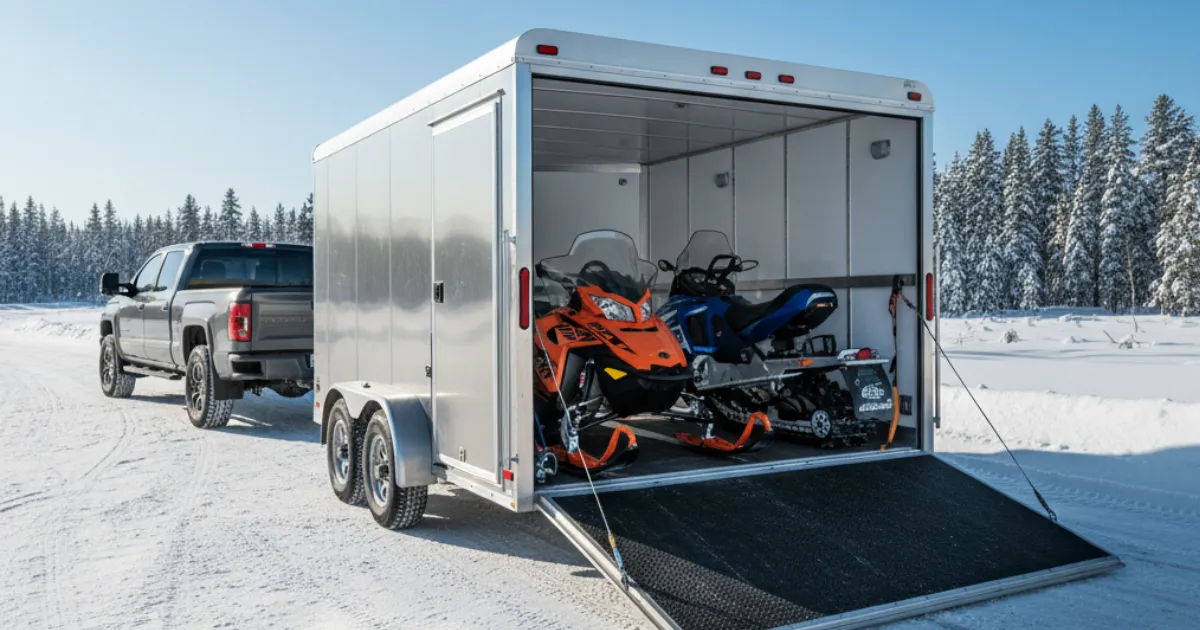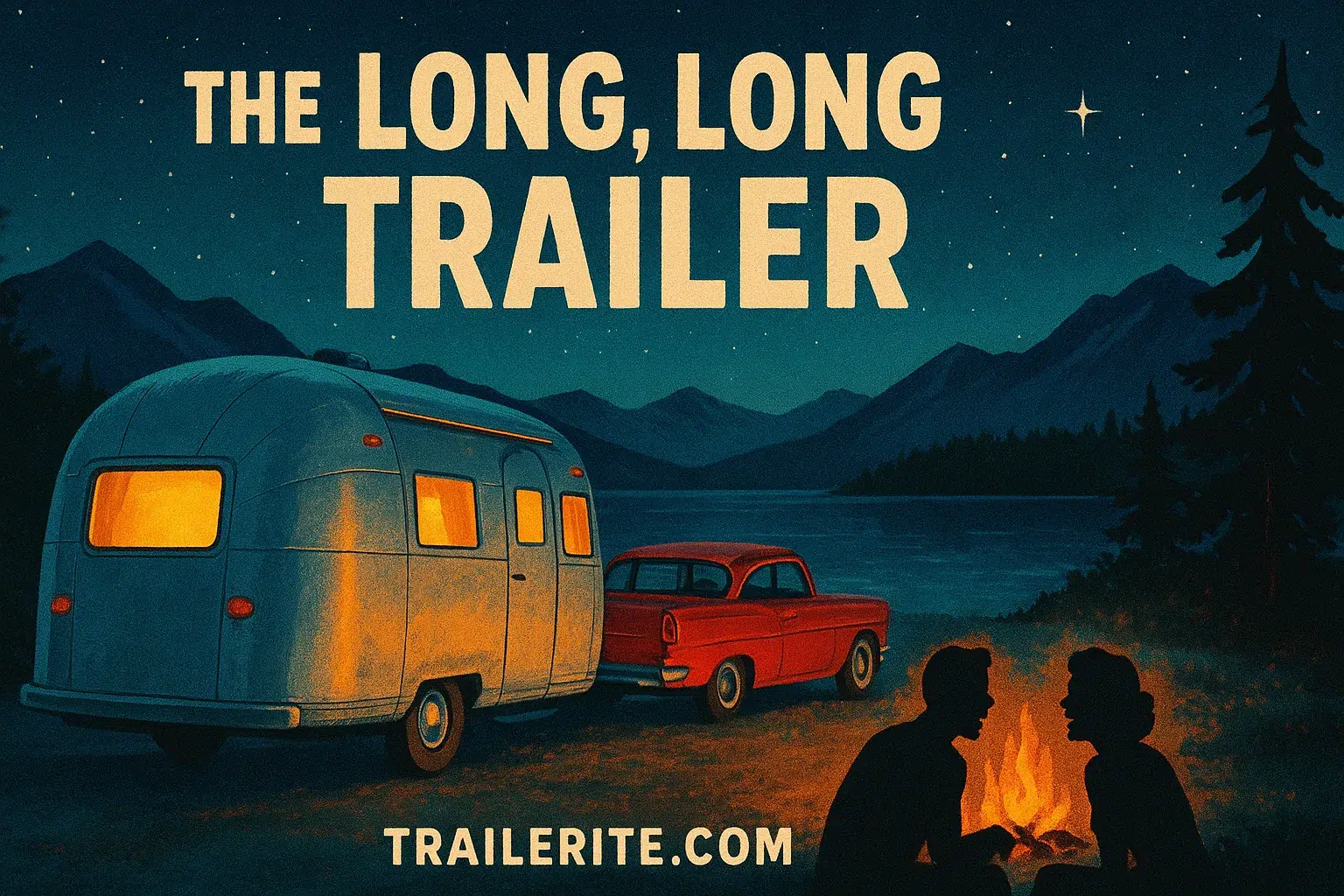For the serious snowmobiler, the passion for fresh powder and remote trails is an unbreakable bond. Yet, that exhilarating freedom is only possible if you can safely, reliably, and efficiently get your expensive equipment from your garage to the trailhead. That’s where the unsung hero of the winter sport—the snowmobile trailer—comes into play.
Choosing the right trailer isn’t just about hauling; it’s an investment in safety, equipment protection, and overall enjoyment of your winter season. It’s a decision that separates the weekend warrior from the dedicated backcountry explorer. As seasoned experts, we’ll guide you through the critical decisions, must-have features, and essential maintenance practices to ensure your sleds—and your adventures—are protected, mile after mile.
Open vs. Enclosed: The Foundational Decision
Your first major choice is the style of trailer, a factor that dictates cost, protection, and versatility. There are three primary types:
1. Open Snowmobile Trailers
An open trailer is essentially a flat deck with side rails and a ramp or tilt mechanism for loading.
- Pros:
- Affordability: The most budget-friendly option.
- Lighter Weight: Easier to tow, requiring a less powerful tow vehicle and offering better fuel efficiency.
- Maneuverability: Generally smaller and easier to park and handle.
- Cons:
- Zero Protection: Your sleds are fully exposed to road salt, snow, slush, gravel, and wind damage. A cover is essential but not a perfect shield.
- Less Security: No lockable security against theft when parked overnight.
- No Gear Storage: You’ll need to carry all your gear and fuel in your tow vehicle.
- Best For: Occasional riders, short-distance hauls, or those on a strict budget who primarily ride in local areas.
2. Enclosed Snowmobile Trailers
The enclosed trailer is a rolling, mobile garage, providing a complete shield for your equipment.
- Pros:
- Maximum Protection: Full defense against the elements, road salt, and debris, preserving the life and finish of your expensive snowmobiles.
- Security: Lockable doors prevent theft and tampering, providing peace of mind during overnight stops.
- Multi-Functionality: Doubles as a secure storage unit, a mobile changing room, or a temporary workshop on the trail.
- Gear Storage: Dedicated space for gear, helmets, fuel, tools, and extra oil.
- Cons:
- Higher Cost: Significantly more expensive than open models.
- Heavier and Larger: Requires a capable tow vehicle and can be more difficult to maneuver and park.
- Less Fuel Efficient: The larger profile creates more wind resistance.
- Best For: Frequent riders, long-distance trips (especially where road salt is used heavily), multi-sled transport, and those who demand the best protection for their investment.
3. Hybrid/Sport Decks (The Honorable Mentions)
Hybrid trailers offer an enclosed front “V” for gear storage with an open rear deck. Sport decks (or sled decks) fit directly into the bed of a pickup truck, carrying sleds above the wheel wells. These are niche solutions for riders prioritizing compact size and minimal tow-behind hassle, though they limit capacity and weather protection.
Critical Considerations for Your Snowmobile Trailer Purchase
Once you’ve settled on the style, the details of construction and feature set are paramount. Ignoring these elements can lead to a purchase that compromises your safety and the longevity of your investment.
Construction Material: Aluminum vs. Steel
The battle between aluminum and steel is a critical one, particularly in the harsh, corrosive winter environment.
| Feature | Aluminum Construction | Galvanized Steel Construction |
| Weight | Significantly Lighter | Heavier |
| Corrosion | Highly Resistant (Ideal for Salt/Slush) | Susceptible to Rust/Corrosion |
| Durability | Excellent, but can be prone to fatigue cracks over time | Very Strong, can withstand more abuse |
| Cost | Higher Initial Price | Lower Initial Price |
Expert Take: For a snowmobile trailer, aluminum is almost always the superior choice. The weight savings are a major factor in towing, but more importantly, aluminum’s natural resistance to the road salt and brine common on winter roads drastically extends the trailer’s lifespan and maintains its resale value.
Axle Configuration and Capacity
Matching the trailer to your cargo is non-negotiable for safety.
- Single Axle: Ideal for small, open trailers hauling one or maybe two compact sleds. They are easier to maneuver but have a lower payload limit and less stability.
- Tandem Axle: The professional standard for larger trailers (especially enclosed models) or hauling three or more sleds. Tandem axles distribute the weight better, offer superior stability at highway speeds, and provide redundancy (you can often limp to safety with a flat on one of the four tires).
Always check the Gross Vehicle Weight Rating (GVWR) of the trailer and compare it to the total weight of your sleds, fuel, and gear. Never exceed this rating, and verify your tow vehicle’s capacity is sufficient.
Loading and Unloading Mechanisms
The efficiency and safety of loading are determined by how you get your sleds on and off the deck.
- Tilt Decks: The entire trailer bed tilts, eliminating the need for separate ramps. This is common on open trailers and can be quick, but the angle can be steep.
- Rear Ramp Door: Found on most enclosed and some open trailers, a built-in ramp makes for simple, straightforward loading.
- Drive-On/Drive-Off (In-Line): The gold standard for multi-sled enclosed trailers. These feature a full-width ramp door on both the rear and the V-nose front, allowing you to drive a sled straight through without having to back it off or turn it inside the trailer.
Essential Snowmobile Trailer Features You Need
Beyond the basics, certain features transform a decent trailer into a truly indispensable piece of winter equipment.
- Integrated Tie-Down System: Look for a system specific to snowmobiles, such as ski hold-down bars or channel-track systems. Ropes and bungee cords are a disaster waiting to happen. The standard is securing the sled at a minimum of four points to prevent any movement.
- Durable Decking/Flooring: The deck must withstand studded tracks and carbide runners. Look for treated or marine-grade plywood, or composite materials. For enclosed trailers, consider slide guides and track mats to protect the floor and aid in loading traction.
- LED Lighting: Winter conditions mean reduced visibility. LED lights are brighter, draw less power, and—crucially—are far less susceptible to failure from cold weather and moisture than traditional incandescent bulbs. Ensure all running lights, brake lights, and turn signals are fully operational before every trip.
- Fuel Doors (Enclosed Only): A small but critical side door that allows you to easily refuel your sleds without having to completely open the main ramp or pull the sleds out.
- V-Nose Design (Enclosed Only): A trailer with a pointed V-nose greatly improves aerodynamics, reducing drag and making for much smoother, more fuel-efficient towing than a blunt square-front trailer.
Master the Road: Safe Towing and Maintenance
The journey is half the battle, and a well-maintained, properly loaded trailer is key to a safe trip.
Weight Distribution is King
Improper weight distribution is the single biggest cause of trailer sway and accidents.
- Rule of Thumb: Aim for 60% to 65% of the cargo weight to be placed in front of the trailer axle(s).
- Tongue Weight: This is the force the trailer exerts downward on the hitch ball. It should be approximately 10% to 15% of the total loaded trailer weight. Too little tongue weight causes dangerous tail-wagging sway; too much puts excessive strain on your tow vehicle’s rear suspension. Load the heaviest snowmobiles first, positioning them to achieve this balance.
Pre-Trip Inspection Checklist
Before you hit the road, a quick but thorough inspection is mandatory:
- Tires and Pressure: Check all tires (including the spare) for proper inflation (match the PSI stamped on the tire sidewall or trailer placard, not your vehicle’s specs). Inspect for dry rot or damage.
- Wheel Bearings: Listen for any grinding or humming. If they’re due for greasing or have play, service them immediately.
- Lights and Electrical: Connect the wiring harness and verify that brake lights, running lights, and turn signals are working perfectly.
- Hitch Connection: Ensure the coupler is fully seated and locked onto the ball, the safety pin is in place, and the safety chains are crossed beneath the coupler.
- Tie-Downs: Tug firmly on each secured snowmobile to confirm it cannot shift.
Off-Season Storage and Maintenance
Your trailer is exposed to the absolute worst of winter. Maintenance is essential.
- Post-Season Wash: Thoroughly wash the entire trailer—especially the undercarriage and axle area—to remove all traces of road salt and grime. A power washer is ideal.
- Lubrication: Grease the wheel bearings and any moving parts (like tilt mechanisms and ramp hinges) before putting the trailer away for the summer.
- Tire Care: Store the trailer out of direct sunlight and consider placing it on blocks to take the weight off the tires, preventing flat spots.
By meticulously evaluating your needs against the features and construction of a dedicated snowmobile trailer, you are not just buying a piece of equipment; you are securing the uninterrupted pursuit of your winter passion. A smart, safe investment today guarantees countless trouble-free rides tomorrow. Now, hitch up, load out, and go chase that fresh snow.
Frequently Asked Questions
What is the best type of trailer for snowmobiles?
The best type depends on your needs. Open trailers are affordable and lightweight, while enclosed trailers offer superior protection from road salt, weather, and theft, making them ideal for long-distance hauling.
Should I buy an aluminum or steel snowmobile trailer?
Aluminum trailers are generally preferred for snowmobiles because they are significantly lighter (easier on fuel/towing vehicle) and resist rust and corrosion from road salt much better than heavier steel trailers.
What size snowmobile trailer do I need for two sleds?
For two snowmobiles, you typically need a trailer that is 7 to 8.5 feet wide and between 12 to 14 feet long. An 8.5-foot width allows for comfortable, side-by-side loading.
How should I safely tie down a snowmobile on a trailer?
You must secure your snowmobile at four points—two in the front (at the skis or spindle mounts) and two at the rear (at the bumper or track). Always use high-quality ratchet straps or specialized clamps to prevent movement.
How much tongue weight should a snowmobile trailer have?
The ideal tongue weight (the downward force on the hitch) should be between 10% and 15% of the total loaded trailer weight. Aim to distribute about 60% of the load weight forward of the trailer axle(s) to ensure stable towing.
How often should I service my snowmobile trailer wheel bearings?
Wheel bearings should be inspected and re-greased annually or approximately every 3,000 to 5,000 miles, especially before and after the winter season, as water and cold can compromise the grease.



